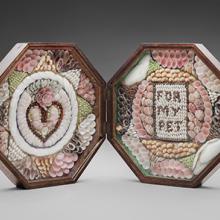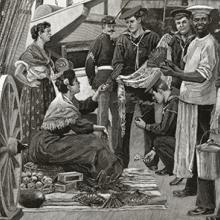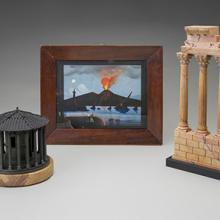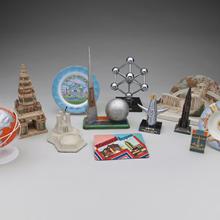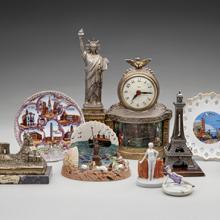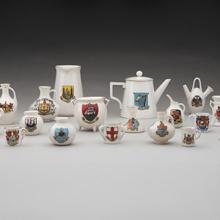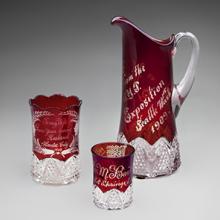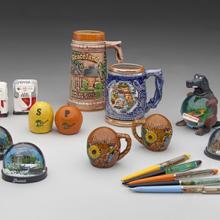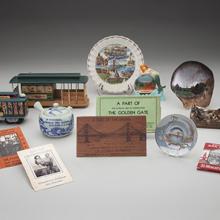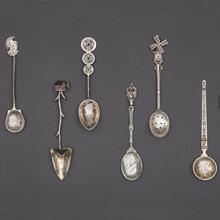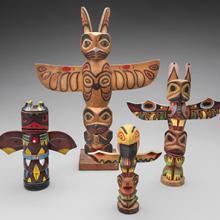Terminal 2










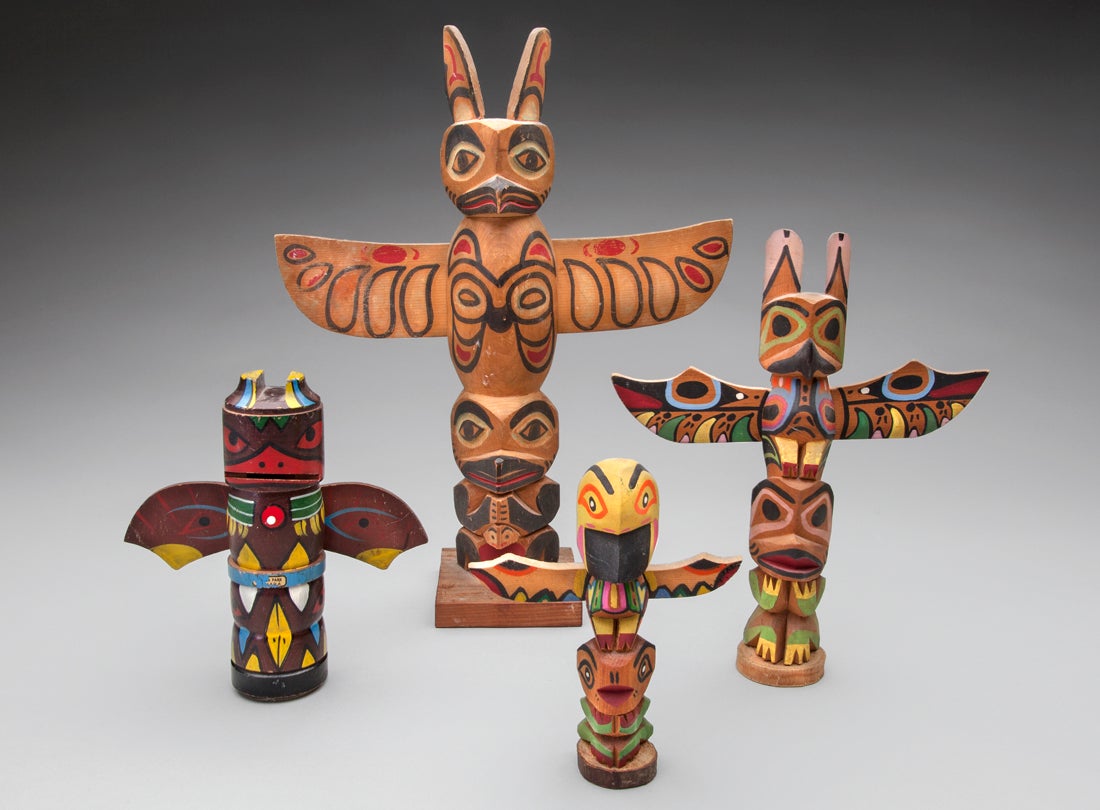
Sailors’ Valentines
Barbados
Courtesy of The Strong, Rochester, New York
74.683
L2012.2101.002
During their travels, sailors often acquired mementos for their loved ones back home. Shell mosaics are presently referred to as sailors’ valentines, because twentieth-century collectors believed that sailors had created these objects. Many sailors did spend time making scrimshaw, wool-work embroidery, and knot work. However, it was Barbados islanders who made sailors’ valentines and sold them to sailors who stopped in their ports. Scholars studied the shells commonly used in sailors’ valentines and discovered that they were in fact native to the West Indies. The similarities in their designs also suggest that sailors’ valentines were created in one place rather than on ships that sailed different routes.
Sailors Buying Souvenirs 1892
Rufus Fairchild Zogbaum
From “All Hands”: Pictures of Life in the United States Navy, 1897
Courtesy of The Mariners’ Museum, Newport News, Virginia
R2012.2117.001
(left to right)
Temple of Vesta c. 1806
Italy
Collection of Capriccio Fine Arts
L2012.2105.007
Painting of Mount Vesuvius and Bay of Naples at night late 1800s
Italy
Anonymous lender
L2012.2102.076
Temple of Castor and Pollux c. 1860
Italy
Collection of Capriccio Fine Arts
L2012.2105.001
During the late seventeenth and eighteenth centuries, generations of privileged young Englishmen, Germans, and Scandinavians traveled on the Grand Tour as part of their formal education. During the nineteenth century, the advent of mass transit made the Grand Tour accessible to greater numbers of travelers, including Americans who could more easily cross the Atlantic Ocean. Those embarking on the Grant Tour typically had a background in classical languages and knowledge of the arts.Tourists often began their journey in London before traveling to France and Italy. Many travelers included additional destinations such as The Netherlands, Germany, and even Greece, to their itineraries. The trip served as a rite of passage that lasted one year or more, with lengthy stays in Rome and Paris. For many, Italy and the ancient ruins of Rome represented the highlight of the trip, where some of the world’s most famous structures including the Pantheon, built in the second century CE, were located.
Travelers returned home with a greater understanding of art and architecture formed by exposure to renowned masterpieces. They acquired souvenirs such as marble busts, paintings, prints, and other artifacts representing classical antiquity for display in their studies and libraries. Grand Tour souvenirs illustrated the knowledge one acquired from their travels and symbolized the tourist’s refined taste.
(left to right)
New York World’s Fair coin bank 1964
United States
Collection of Ace Architects
L2012.2105.015
Panama Pacific International Exposition Elephant Tower box 1915
United States
Collection of Ace Architects
L2012.2105.028
A Century of Progress dish 1933
United States
Collection of Ace Architects
L2012.2105.029a,b
New York World’s Fair plate 1965
Japan
Anonymous lender
L2012.2110.005
New York World’s Fair bank and thermometer 1939
United States
Collection of Ace Architects
L2012.2105.024
A Century of Progress sewing kit 1933
United States
The Lace Museum, Sunnyvale, California
2010.1349.018
L2012.2107.004
Atomium 1958
Brussels, Belgium
Collection of Ace Architects
L2012.2105.009
Tower of the Sun 1970
Japan
Collection of Ace Architects
L2012.2105.013
Model of the Tower of the Sun 1939
United States
SFO Museum
1999.267.001
L2012.2113.007
New York World’s Fair Italian Pavilion 1939
United States
Collection of Ace Architects
L2012.2105.018
Golden Gate International Exposition cigarettes 1939
United States
SFO Museum
1999.215.001
L2012.2113.005
Golden Gate International Exposition ashtray 1939
United States
Anonymous lender
L2012.2102.029
New technologies such as the moving picture and the computer were first introduced at world’s fairs. But new inventions were only part of world’s fairs, which also featured a variety of cultural exhibitions and entertainment. The Panama Pacific International Exposition, held in San Francisco in 1915, celebrated the completion of the Panama Canal. It also helped the city recover economically after it was nearly destroyed by the 1906 earthquake and fire. The Fair featured a scaled replica of the Panama Canal that covered five acres.
The Century of Progress International Exposition was held in Chicago in 1933–34. Shortly after, the 1939 New York World’s Fair introduced the television, FM radio, and color photography. At the same time, the Golden Gate International Exposition celebrated the completion of the Golden Gate and the Bay bridges. Man-made Treasure Island was created specifically for the Exposition in San Francisco.
By 1958, the Brussels World’s Fair demonstrated how rapidly technology was progressing. The Fair’s Atomium showcased the achievement of atomic energy. It consisted of a giant 360-foot steel and alloy structure. A few years later, the Seattle World’s Fair, “Century 21 Exposition” featured the famous Space Needle. The 600-foot observation tower featured a revolving restaurant atop its saucer-shaped platform. The last of the great world’s fairs was held in Osaka, Japan, in 1970. It was the first major international exposition to be held in Asia. The painter and sculptor Taro Okamoto created the symbolic monument, the Tower of the Sun, to embody the exposition’s theme “harmony and progress for all.”
(clockwise)
Souvenir de Paris c. 1940
France
Collection of Ace Architects
L2012.2105.022
Boston Monuments plate c. early 1900s
Austria
Anonymous lender
L2012.2102.027
Statue of Liberty clock c. 1945
United Clock Corp.
Brooklyn, New York
Courtesy of The Strong, Rochester, New York
103.266
L2012.2101.004
Eiffel Tower inkwell and thermometer c. 1890
France
Collection of Ace Architects
L2012.2105.039
Las Vegas Fremont Street plate c. 1960
Japan
Anonymous lender
L2012.2110.105
Bunker Hill Monument mug c. early 1900s
Germany
Anonymous lender
L2012.2102.021
Bathing beauties ashtrays c. 1920s
Germany
Anonymous lender
L2012.2102.005,.002
Statue of Liberty light c. 1950s
United States
Courtesy of The Strong, Rochester, New York
103.593
L2012.2101.00
Souvenir collecting has taken place for centuries. Travelers purchase, collect found objects from the natural environment, and even steal what they consider to be harmless tokens of their travels. Hotel ashtrays are particularly popular clandestine keepsakes. But acquiring souvenirs illicitly is nothing new. In 1786, Thomas Jefferson and John Adams traveled to Stratford-upon-Avon to visit the home of William Shakespeare. Supposedly, at some point during the tour the two American statesmen carved a few slivers from a wooden chair that was allegedly Shakespeare’s and took them home as souvenirs.
Today, vacationers continue to acquire souvenirs in unprecedented numbers. Souvenirs commemorate trips and capture the exotic or foreign atmosphere of a place. They also serve as useful or decorative items and are given as gifts to family and friends. Sometimes these souvenirs are quality examples of indigenous crafts or close reflections of architectural, cultural, and historic sites. At other times, they are merely frivolous trinkets that signify a well-known symbol such as the Tower of London or the Loch Ness monster.
Heraldic China c. 1890–1900
United Kingdom
Courtesy of the Lena Marianne Fahys Family
L2012.2111.007,.031,.079,.075,.078,.077,.090,.076,.038,.092,.070a,b,.024,.033,.055,.027,.065,.018
Heraldry developed in the 1100s throughout Europe so that armored men in battle could identify one another. Shortly after, each noble family had their own shields. Eventually cities and towns also developed coats-of-arms. Armorial dinner services became fashionable among the aristocracy in the eighteenth century. By the mid-1800s, the Industrial Revolution in England enabled the general public to afford porcelain. The Englishman William Henry Goss (1833–1906) first began making miniature heraldic china in the 1880s at his Falcon Pottery at Stoke-on-Trent. His small versions of ewers, jugs, urns, and other shapes decorated with imagery associated with various British towns and their coats-of-arms quickly became popular. Other Staffordshire potteries as well as German and Austrian firms also began to make similar wares.
The Industrial Revolution in England resulted in greater numbers of people who could now afford to escape to the seaside via train on short holidays. In response, British coastal towns teemed with heraldic china from the 1880s to the 1930s to fulfill the new tourists’ desire to take home small keepsakes from their excursions. At the turn of the twentieth century in England, nearly every household had at least a few pieces of miniature heraldic china in their homes.
Atlantic City glass 1902
Eastern United States
Courtesy of Ian Berke, San Francisco, California
L2012.2109.018
Alaska-Yukon-Pacific Exposition pitcher 1909
Eastern United States
Courtesy of Ian Berke, San Francisco, California
L2012.2109.003
Hot Springs, South Dakota glass 1908
Eastern United States
Courtesy of Ian Berke, San Francisco, California
L2012.2109.013
Ruby-Stained Glass
Ruby glass was a popular keepsake found at world’s fairs and regional fairs as well as popular resorts, such as Atlantic City. This pressed glass was widely produced in Ohio and Pennsylvania where glass-making industries were located. Pieces were molded in a variety of forms, from pitchers to wine glasses. Ruby glass is named for the dark red color of the precious gemstone known as a ruby. The red color is added to clear glass by a process called staining. Stained glass has color painted onto the clear glass. Then it is re-fired so the stain fuses with the glass. Ruby-stained glass was mostly made from the 1880s through the 1930s. Separate firms often completed the inscriptions. Etchers inscribed the ruby-stained decoration with names, dates, and places, noting various cities, towns, and resorts. Often verses expressing the sentimentality of the Victorian era were inscribed on the glass such as, “for my wife from your loving husband” or “remember me.”
(clockwise)
Salt-and-pepper shakers c. 1950s
Japan
Anonymous lender
L2012.2110..019a,b,.021a,b
Graceland mug c. 1970s
Japan
Anonymous lender
L2012.2110.023
Florida mug c. 1970s
Japan
Anonymous lender
L2012.2104.001
Snow globes c. 1950s–70s
Hong Kong
Anonymous lender
L2012.2110.034,.036
Floaty pens c. 1950s–70s
Hong Kong
Courtesy of Mickey McGowan, San Rafael, California; and anonymous lender
L2012.2112.024.04, L2012.2110.024, L2012.2112.024.01,.06,.07
Kansas salt-and-pepper shakers c. 1950s
Japan
Anonymous lender
L2012.2110.020a,b
Mass-Produced Souvenirs: From Floating Action Pens to Snow Domes
After World War II, a desire for playful souvenirs developed. Snow domes, floaty pens, salt-and- pepper shakers, mugs, ashtrays, and magnets were some of the colorful trinkets that the general public began acquiring at roadside attractions, parks, and historical sites across the country. The ubiquity and low cost of these types of souvenirs made them easily accessible to nearly everyone.
The Eskesen Company, located in Denmark, first manufactured floaty pens in 1946. The company, which officially calls these writing implements Floating Action Pens, has produced over one-half billion pens. They continue to make more of these pens than any other manufacturer.
Water-filled glass snow globes originated in France in the late 1800s. After the 1889 Paris Exposition featured miniature Eiffel tower versions of these novelties, the craze for snow globes quickly followed. The 1939 New York World’s Fair also featured snow globes as keepsakes of the event. By the 1950s, low-cost plastic versions of glass snow domes had become ubiquitous at souvenir stands throughout the nation.
(clockwise)
Powel & Mason cable car models c. 1950s
United States
SFO Museum
1999.619.001, L9816.68.029
L2012.2113.010,.012
San Francisco plate c. 1950s
Japan
Anonymous lender
L2012.2110.008
San Francisco snow globe c. 1950s–70s
Hong Kong
Anonymous lender
L2012.2110.039
Cliff House painted shell c. 1930s–40s
San Francisco, California
Anonymous lender
L2012.2102.014
Cliff House c. 1950s
Dodge
United States
Collection of Ace Architects
L2012.2105.026
San Francisco souvenir postcard packet c. 1940s
United States
Courtesy of Mickey McGowan, San Rafael, California
L2012.2112.012.05
San Francisco plate c. 1950s
Japan
Anonymous lender
L2012.2110.014
Official souvenir from the construction of the Golden Gate Bridge c. 1937
United States
SFO Museum
1999.438.001–.002
L2012.2113.008.01–.03
Gay 90s Studio, International Settlement, San Francisco c. 1940s
San Francisco, California
Courtesy of Mickey McGowan, San Rafael, California
L2012.2112.006
Greetings from Chinatown photo card c. 1940s
San Francisco, California
Courtesy of Mickey McGowan, San Rafael, California
L2012.2112.004
Hagiwara Japanese Tea Garden, Golden Gate Park, teapot with lid c. 1940s
United States
SFO Museum
1999.611.001
L2012.2113.009
California: The Golden State
California has long drawn visitors for its sunshine, rugged coastline, deserts, and fertile valleys. After the railroads were installed as far as the West Coast, greater numbers of travelers came to view the natural wonders of the golden state. American railroad companies and local California businesses encouraged tourists to see the redwood forests and Yosemite Valley. In later decades, aside from natural sites, engineering feats and movie stars have also drawn visitors to the cities of San Francisco and Los Angeles.
Colorful cable cars, iconic emblems of San Francisco, continue to provide public transportation to local residents and tourists. First introduced in 1873, the cable cars operate as they did in the nineteenth century, by a mechanism that grips cables that run beneath the street. Since its opening in 1937, the Golden Gate Bridge, brightly painted in a shade called international orange, has stood as an important American landmark and symbol of San Francisco. The famous engineering feat is one of the most photographed bridges in the world.
Visitors to California have also historically been attracted to Southern California and the glamour of Hollywood. Over the years, dozens of top stars left their hand and footprints in freshly poured cement in front of Grauman’s Chinese Theatre, which opened in 1927. Even more famous, the Hollywood sign, a worldwide symbol of the motion picture industry, was originally intended to advertise a suburban housing development called Hollywoodland. The sign, which has endured for more than eighty years, was erected in 1923. In 1949, “land” was finally dropped.
Spoons c. 1870s–90s
Europe and United States
Courtesy of the Lena Marianne Fahys Family
L2012.2111.100,.106,.101,.103,.099,.096,.097,.110
In Europe, beginning about the time of the Crystal Palace exhibition in London (1851), souvenir spoons became favored keepsakes of visited places and events. Spoons were especially popular during the era of train travel because they were easily transportable. In the United States, the souvenir spoon craze began in 1890 and lasted for approximately thirty years. Chicago’s 1893 World’s Columbian Exposition provided the impetus for collecting spoons. Dozens of firms manufactured these fashionable items, which were sold throughout the country.
(clockwise)
Totem pole bank c. 1960s
Canada
Anonymous lender
L2012.2110.047
Totem pole c. 1930s
Alaska
Anonymous lender
L2012.2110.048
Totem pole c. 1950s
probably Canada
Anonymous lender
L2012.2110.049
Totem pole c. 1950s
Anonymous lender
Canada
L2012.2110.050
Native American Souvenirs
The production of souvenirs or tourist art became an important source of income for many Native Americans who were forced to adapt to a rapidly changing environment in the 1800s and early 1900s. Birch bark miniatures, jewelry, beadwork, basketry, and pottery were popular souvenir items at many locations that sold Native American crafts. Knockoffs also appeared at souvenir stands from the Southwest to the Northeast. Whether authentic or not, such souvenirs allowed travelers to return home with romanticized notions of North America’s indigenous peoples.
Totem poles originally conveyed the history, legends, and ancestry of various Northwest Coast tribes. These tall, carved poles were placed at house fronts, served as interior house posts, and were used as freestanding memorials to honor deceased chiefs. In the 1800s, Northwest Coast artisans began making wooden miniatures of totem poles for sale to tourists and collectors. In the Northeastern United States and Canada, the Iroquois crafted beaded souvenirs for sale, particularly around tourist destinations such as Niagara Falls.
The Santa Fe Railway and the Fred Harvey Company built hotels, restaurants, and shops to promote mass tourism to the Grand Canyon, New Mexico, and Southern California by train during the late 1890s to the mid-1900s. The Harvey Company encouraged the sale of Southwestern Native arts. They supplied Navajo and Pueblo artisans with the necessary materials to craft jewelry for sale to tourists and collectors. This genre of silver and turquoise jewelry is collectively known as “Fred Harvey type jewelry.”
Santo Domingo is one of the Rio Grande pueblos in northern New Mexico. In the late 1930s and early 1940s, it was difficult to obtain the traditional shell or jet used to make jewelry, so the artisans in Santo Domingo used pieces of old car batteries, vinyl records, and colored plastic items to craft souvenirs necklaces.
